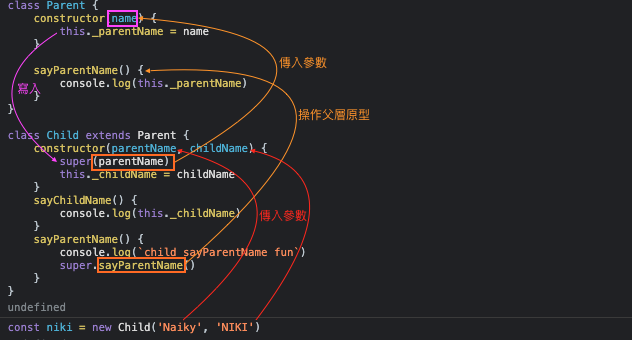Class 類
Javascript 本身沒有 class (類),在 ES6 出現新語法 class 就是依 Constructor 建構函式 語法糖包裝的,它的底層與 Constructor 建構函式 是完全一樣,只是提供更簡潔的語法來建立物件與處理繼承。
簡單說
Class 只是簡化了 JavaScript 中操作 Constructor 的語法糖。
建立基本 Class
js
class Person {
// 定義實例屬性
constructor(name, age) {
this.name = name
this.age = age
}
// 定義 prototype 原型方法
sayHello() {
console.log(`Hello my name is ${this.name}`)
}
}
流程
- 聲明
class的命名物件{} - 定義 屬性資料
- 內部創建一個
consturctor的函式,來定義這個實例的 屬性資料。
- 內部創建一個
- 定義 原型方法
prototype- 內部直接寫上 函式 (這個部份,就是 建構函式中的
prototype的方法) 之後也可以透過.prototype來新增函式方法
- 內部直接寫上 函式 (這個部份,就是 建構函式中的
創建實例
跟 Constructor 建構函式 一樣都是使用 new 關鍵字。
js
const niki = new Person('niki', 6)
注意
class 沒有 hoisting (提升),你必須先宣告才可以使用,不然會出現錯誤。
js
// ReferenceError
const niki = new Person('niki', 6)
class Person{ ... }
原型方法 prototype
可以提供 實例 instance 共享操作方法的設置,直接在 class 物件內建立函式,就是原型方法了。
js
class Person {
// 定義實例屬性
constructor(name, age) {
this.name = name
this.age = age
}
// 定義 prototype 原型方法
sayHello() {
console.log(`Hello my name is ${this.name}`)
}
}
建立子類別 (extends)
建立 class 時,加上 extends 關鍵字,可以用來繼承 父層 class 的 原型方法,同時也會將 父層 屬性資料,變成 子層 屬性資料 (寫入)。
class
子層extends父層
js
class Parent {
constructor(name) {
this._parentName = name
}
sayParentName() {
console.log(this._parentName)
}
}
class Child extends Parent {
sayChildName() {
console.log('Child')
}
}
const niki = new Child('NIKI')
說明
子層 會繼承 父層 的 屬性資料,父層 的 _parentName 會變成 子層 的 屬性資料,當 子層實例 傳入 參數 時,就會設置成 _parentName;子層實例 除了有本身的 原型 也繼承了來自 父層 原型。 
Error
當 子層 有設置 constructor 時,就必須要使用 super 不然就會報錯:
Uncaught ReferenceError: Must call super constructor in derived class before accessing 'this' or returning from derived constructor
呼叫父類別 (super)
在繼承 父層 class 情況下的 子層 class,在可在物件內使用 super 來操作 父層 class。
js
// 父層
class Parent {
// 父層 屬性資料
constructor(name) {
this._parentName = name
}
// 父層 原型方法
sayParentName() {
console.log(this._parentName)
}
}
// 子層 (繼承父層)
class Child extends Parent {
// 子層屬性資料
constructor(parentName, childName) {
super(parentName) // 父層 屬性資料 賦值 (帶入父層參數)
this._childName = childName
}
// 子層 原型方法
sayChildName() {
console.log(this._childName)
}
sayParentName() {
console.log(`child sayParentName fun`)
super.sayParentName() // 操作父層 原型方法
}
}
js
const niki = new Child('Naiky', 'NIKI')
niki.sayParentName()
// child sayParentName fun
// Naiky
說明
從 子層 constructor 的 super 帶的參數,會直接送到 父層 constructor,再回頭寫入 子層 constructor。
而 子層 prototype 函式內的 super.sayParentName(),就是直接操作 父層 prototype 的 sayParentName 函式。

簡單說
super 代表 父層 class 物件。
注意
- 子類 的
super(),在放在this使用之前。 - 當 子層
constructor的屬性名稱與 父層constructor屬性名稱 相同 時,會以 子層 為主 (覆蓋)。 - 當 子層
prototype與 父層prototype同名 時,會先執行本身 子層prototype。(若無,向上層尋找)
私有屬性
當屬性名稱以 # 為前綴時,就會被認為是「私有」的屬性,只可以在聲名這個變數的 class 中被訪問,外部無法訪問。
js
class Person {
#firstName
constructor(firstName) {
this.#firstName = firstName
}
get firstName() {
return this.#firstName
}
}
const niki = new Person('NIKI')
niki.firstName // 'NIKI'
niki.#firstName // Uncaught SyntaxError: Private field '#firstName' must be declared in an enclosing class